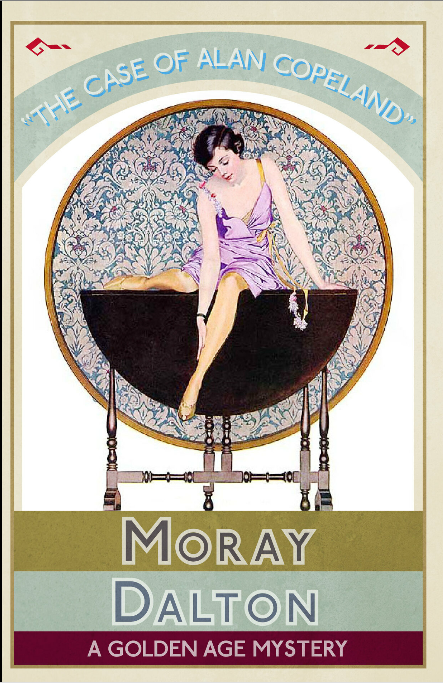
Dean Street Press has decided beneficently to rescue Golden Age author Moray Dalton from undeserved obscurity and reprinted 10 of her books. We who are unfamiliar with this author have much to look forward to.
Katherine Mary Deville Dalton (1881-1963) fell into a life of crime, so to speak, after publishing women’s fiction. Her first mystery was released in 1924 and it was succeeded by 28 more, the last one in 1951. Most of them featured Scotland Yard Inspector Hugh Collier or private detective Hermann Glide.
The Case of Alan Copeland (Sampson Low, 1937; Dean Street Press, 2019) was one of her stand-alone stories, set in a village with all manner of sharply defined characters, many of them unlikeable. Alan Copeland is married to a woman some 15 years his senior, who bullies him relentlessly. The vicar’s niece Lydia comes to visit for a few days and the two fall hopelessly in love. They correspond after her return to London until Alan’s wife dies suddenly. They marry immediately and travel for months, then move back to the village. Anonymous letters to the police prompt an investigation that results in an exhumation order. An autopsy shows Alan’s wife died of arsenic poisoning, and some 18 months after her death, Alan is arrested for her murder. Both Alan’s solicitor and the private investigator the solicitor hired exert considerable effort on his behalf and uncover significant ammunition for his barrister, resulting in a lively courtroom drama.
The DSP reprint opens with an informative preface by crime fiction historian Curtis Evans, who compares Dalton, especially her later books, to Agatha Christie and Margery Allingham. The Case of Alan Copeland has long sections of text that I could easily have mistaken for bits from an Agatha Christie mystery. Of course the village settings are similar. Dalton’s characterization differs from Christie’s, though, in that unpleasantness in Christie’s characters is generally suggested or implied. There might be a raised eyebrow or a look askance among the village ladies when they want to convey disagreement or disapproval. Dalton’s characters, on the other hand, do not hesitate to let fly verbally as their inclinations take them. They are seriously nasty people and seem to take pride in their offensiveness.
The other difference, as Evans points out, is in Dalton’s willingness to incorporate relationships that fall outside societal norms into her tales. Both an extramarital affair and an out-of-wedlock pregnancy take place in this story. Neither generate the repercussions that might have been expected, as Evans observes. Christie dealt with these behavioral anomalies mostly by ignoring them. She might mention a servant “in trouble” but these things did not occur in the other classes. I can’t remember an instance of an extramarital fling in a Christie. Even the servants who went astray were single.
Evans mentions one of the reasons that Dalton fell into obscurity as possibly her failure to capture the U.S. readership. I am wondering if Dalton’s acknowledgement of atypical relationships may have contributed to that failure. The United States is the country of The Scarlet Letter and the Hays Code, after all, and the 1940s and 1950s were particularly strict about behavioral expectations. Individuals who conducted themselves outside established parameters were shunned or otherwise faced consequences that at least in this book did not occur. Fortunately in 2020 people are more tolerant.
I found this book well-written and soundly plotted with some nice surprises. The characters are clearly delineated and are entirely credible. I now understand the enthusiasm of Curtis Evans for this author and can only echo it in my recommendation of this author to readers of classic mysteries.
Thanks for this interesting review. I was particularly intrigued by this comment that you make:
The United States is the country of The Scarlet Letter and the Hays Code, after all, and the 1940s and 1950s were particularly strict about behavioral expectations. Individuals who conducted themselves outside established parameters were shunned or otherwise faced consequences that at least in this book did not occur.
I was intrigued as whilst looking at female sleuths this week, it came to me that US writer were far more likely to include a young female character who drinks a lot and/or lives it up. Craig Rice and Elizabeth Deane spring to mind. The women are not looked down upon or punished in the stories for their wilder living.
I appreciate drinking and dancing is not quite a child out of wedlock or an extramarital affair, but I felt the drinking patterns of some US female characters from the 30s and 40s would not have been created by a British author at the same time.
I would be interested to hear your thoughts on the matter.
LikeLiked by 1 person
That’s an interesting observation. Alcohol is not the problem in the U.S. that sex is. The Pilgrims left the Mayflower to go on shore when they ran out of beer. The U.S.did prohibit alcohol for a time but it’s largely been accepted and in some eras encouraged. I agree those characters are not at all in the British mold, now that you mention it. I expect those young ladies might find certain social doors closed to them, if they were interested in opening them to begin with, but those are doors that are hard to open any way.
I think that may be what startled me so much about the characters in this book, their outspokenness is not what I expected in an English village, or really anywhere else in England. A study of differences in transatlantic characterization like this would be fascinating. Thank you for your thoughtful comment!
LikeLiked by 1 person